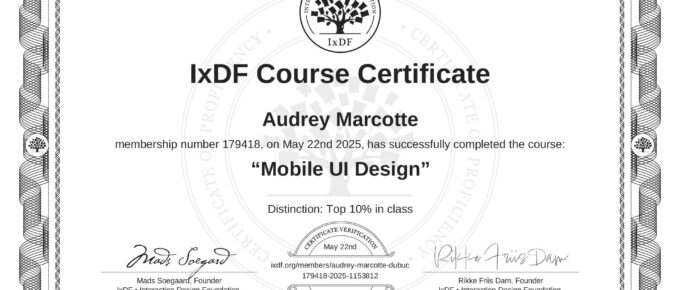Myriam and I studied graphic design together. After working for over 15 years in a top design agency, she lost her job in 2024. Instead of seeing it as a setback, she took it as an opportunity to reinvent herself and move into UX design. Her journey inspired me to write this article.
Becoming a UX Designer: It’s Possible (and Easier Than You Think)
UX design is attracting more and more professionals looking to switch careers: graphic designers, engineers, marketers, teachers, and many others. In 2025, opportunities are booming, and resources have never been more accessible.
But with so many options—bootcamps, Google certificates, university programs, and endless articles—it’s easy to feel lost.
Take a deep breath: here’s a clear roadmap to successfully transition into UX, with reliable resources and actionable tips.
Why Choose UX Design?
If you’ve landed on this article, you’re probably already thinking about it. Here’s why UX is more relevant than ever:
- High demand: Companies need professionals who can create seamless, intuitive experiences.
- Interdisciplinary advantage: Skills from graphic design, development, psychology, marketing, and more can give you a competitive edge.
- Future-proof career: With accessibility, AI, and ethical design on the rise, UX remains at the heart of innovation.
The Best UX Training Options
1. University Programs
For a solid academic foundation, consider programs like:
- Interaction Design (my own background)
- HCI (Human-Computer Interaction)
- Mixed programs combining design + technology
Best for: Those seeking a recognized diploma.
Limitation: Significant time and financial investment.
2. Google UX Design Certificate (Coursera)
→ Discover the program on Coursera
- Format: 100% online
- Duration: ~6 months (10 hours/week)
- Content: User research, prototyping, usability testing, and portfolio creation
- Cost: Around $49 USD/month
My take: Great for learning the basics, but you’ll need to supplement it with real-world projects to land a job.
3. Interaction Design Foundation (IxDF)
If I had to recommend just one platform, it would be IxDF. Here’s why:
- In-depth, continuously updated content
- Learn at your own pace—perfect if you’re working full-time
- Access to a global, active UX community
- Numerous real success stories from career changers
Pro tip: Start with their free articles to get a feel for the quality. Then, invest in the annual membership to unlock all courses and structure your learning path around your goals.
What I especially like is that many IxDF courses require you to create deliverables—wireframes, mockups, prototypes—that you can reuse for your portfolio. Learning and building at the same time? Win-win.
A few inspiring testimonials:
- “How Interaction Design Foundation Has Been Crucial to My UX Design Career Change-A Review” by Bob Ruediger
- “How IxDF Helped Me Build a UX Career from a $1 Logo Gig — My Journey from Factory Job to Full-Time Designer” by Stefan Milenkovic
4. Bootcamps and Hybrid Programs
If you need a structured approach or personalized coaching:
- Merit America: Includes career coaching + Google Certificate
- CareerFoundry: Project-based learning with mentorship
- Ironhack / Le Wagon: Intensive, collaborative, and fast-paced
Your UX Career Transition Roadmap
- Choose Your Starting Point
- Beginner? Start with the Google UX Certificate
- Serious about a career change? Explore IxDF’s catalogue and create a custom learning plan
- Need more structure and mentorship? Go for a bootcamp
- Build Your First Portfolio
Even if you start with fictional projects, a portfolio is essential to showcase your skills. Use this as an opportunity to master key UX tools like Figma, Axure, Balsamiq, Mockflow, and others. - Join UX Communities
Networking matters. Engage on Slack, LinkedIn, and IxDF groups—many UX job opportunities are shared there first.
Next Step? Keep Learning.
UX is a marathon, not a sprint. Invest in continuous learning:
- I personally still rely on IxDF and Nielsen Norman Group (NN/g) after 15 years in the field.
- Develop your soft skills too—persuasion, storytelling, and communication are key to becoming a well-rounded designer.
Conclusion: Is 2025 Your Year to Become a UX Designer?
If Myriam could make the leap, so can you ;). Start small, stay curious, and build consistently:
- Google UX for the basics.
- IxDF to go deeper and master key concepts.
- Build your portfolio to prove your skills.
- And above all: curiosity, empathy, and practice. 🙂
The secret? Learn by doing. Everything else is just a matter of time… and coffee. 😉


